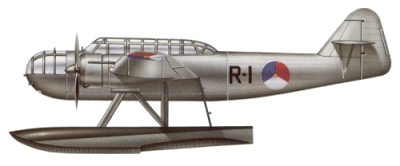
A Fokker T.VIII-Wm used by the Luftwaffe at a base in the Aegean Sea
where the See-Aufklärungsgruppe operated
Fokker's intensive
activity in the years prior to World War II led to the creation in 1938
of a twin-engine seaplane for naval use. It was conceived to meet the
needs of the Dutch navy but paradoxically ended up being used by the
enemy, the Germans. This aircraft was the T.VIII-W. Out of a total of
36 planes built, 28 bore the German insignia and served in naval
reconnaissance and relief duty mainly In the Mediterranean area and the
North Sea.
The T.VIII-W project
was launched in 1937 in response to official specifications issued by
the Dutch navy calling for a new twin-engine seaplane capable of
carrying a torpedo inside its fuselage (with the option of substituting
this type of armament with ordinary bombs) to be used principally in
coastal defence. Moreover, the aircraft was to have a long range and
good cruising speed. In 1938, an order was placed for five production
series aircraft, which were completed by June of the following year.
Despite the existence of several problems in tuning the aircraft, the
Dutch navy was so satisfied with the T. VIII's characteristics that a
subsequent order for 26 planes was signed shortly after. These aircraft
were to go into service in the East Indies, although none reached this
destination. In fact, the outbreak of war halted all plans since the
German invasion led to the occupation of the Fokker factory before the
lot in production had been completed, and the T.VIII-Ws, once built,
were all requisitioned into German service.

The twin-engine Fokkers
were built in three versions, the T.VIII-Wg (19 aircraft),
characterized by its mixed wood and metal structure, the all-metal
T.VIII-Wm (12 aircraft) and the T.VIII-Wc (5 aircraft), with mixed
structure and covering but larger overall. Nineteen of the first type
were built, 12 of the second, and five of the third. The T.VIII-Wcs
were built on the basis of an order issued by the Finnish air force in
1939. They were characterized by a fuselage that was lengthened some 5
ft 11 in (1.80 m), by wings that were lengthened almost 6 ft 7 in (2.01
m), and an increased wingspan of 86.11 sq ft (8.00 sq m) as well as by
the installation of 890 hp (664 kW) Bristol Mercury XI engines. All the
other aircraft were supplied with a pair of American Wright R-975-E3
Whirlwind 9-cylinder single row, air-cooled radial engines, generating
450 hp (336 kW) each and driving two-bladed metal propellers. A single
landplane based T.VIII-L was built for Finland, but was seized by the
Germans when the factory was overrun.
The Fokker T.VIII-W was
a twin-engine mid-wing monoplane, characterized by the presence of two
large duralumin floats. The fuselage had an extensively glazed nose
that housed the observer's post. Immediately behind the pilot's station
was the compartment for the radio operator who had a flexible machine
gun at his disposal for the defence of the rear sector. A second fixed
weapon, installed in a half-wing, was controlled by the pilot. The bomb
load consisted of a maximum of 1,300 Ibs (600 kg) of bombs or a
torpedo.
Apart from its use in
the German navy, the Fokker T.VIII-W (in another twist of fate) served
in the same roles and in the same theatre of war, in the North Sea, in
a British Coastal Command unit. Meanwhile, eight T.VIII-Ws had been
flown to England along with other Dutch floatplanes on 14 May 1940, and
on 1 June 1940 No.320 (Dutch) Squadron RAF was formed at Pembroke Dock,
to operate the T.VIII-Ws on convoy escort work. These aircraft carried
RAF markings, plus a small Dutch triangle badge. Three of the aircraft
were lost, and with no spares available the remaining aircraft were
flown to Felixstowe for storage, They were joined by another in May
1941, when four Dutchmen escaped from Amsterdam and brought their T.VII-W
down on the sea near Broadstairs.
Germany Navy use of the
Fokker T.VIII-W was mostly confined to patrol duties in the
Mediterranean.
Specifications (Fokker
T.VIII-wg)
Type: Three Seat
Torpedo Bomber & Reconnaissance Floatplane
Design: Fokker
Design Team
Manufacturer: N.
V. (Nederlandsche Vliegtuitenfabriek) Fokker in Amsterdam
Powerplant: (T.VIII-W)
Two 450 hp (336 kW) Wright R-975-E3 Whirlwind 9-cylinder single row,
air-cooled radial engines. (T.VIII-Wc) Two 890 hp (664 kW) Bristol
Mercury XI engines.
Performance:
Maximum speed 177 mph (285 km/h); cruising speed 137 mph (220 km/h);
service ceiling 22,310 ft (6800 m); climb to 9,845 ft (3000 m) in 7
minutes 48 seconds.
Range: 1,709
miles (2750 km) on internal fuel.
Weight: Empty
6,834 lbs (3100 kg) with a maximum take-off weight of 11,023 lbs (5000
kg).
Dimensions: Span
59 ft 0 1/2 in (18.00 m); length 42 ft 8 in (13.00 m); height 16 ft 4
3/4 in (5.00 m); wing area 473.63 sq ft (44.00 sq m).
Armament: One
7.9 mm (0.31 in) forward firing FN-Browning machine-gun on port side of
fuselage and one similar single gun on pivoted mount in rear cockpit
plus up to 1,334 lbs (605 kh) of bombs or a single torpedo carried
internally.
Variants: T.VIII-W
(prototype), T.VIII-Wg (wood and metal structure, T.VIII-Wm (all
metal), T.VIII-Wc (mixed structure and larger aircraft built for
Finland), T.VIII-L (a single aircraft built for Finland).
Avionics: None.
History: First
delivery (prototypes) June 1939; first delivery (Mk I) January 1937;
first flight (Mk V) December 1938; first delivery (Mk V) August 1939;
production terminated in June 1943.
Operators:
Netherlands, Germany (Luftwaffe) |
